Oxherding Pictures - Index - Terebess Asia Online (TAO) (original) (raw)
ZEN IRODALOM ZEN LITERATURE ****« Zen index** « Home
十牛圖
십우도
Shiniu tu
The Ten Oxherding Pictures
General Foreword and Introductions by Ciyuan 慈遠
First verses by 廓庵則和尚Kuoan Ze heshang = 廓庵師遠Kuoan Shiyuan
Second verses by 石皷夷和尚= 石鼓夷和尚Shigu Yi heshang = 石鼓希夷Shigu Xiyi
Third verses by 壞衲璉和尚= 壊納璉和尚Huaina Lian heshang = 壞衲大璉Huaina Dalian
English translation by 千崎如幻 Senzaki Nyogen (1876–1958) and Paul Reps (1895-1990)
With Commentary by Ji Bong
http://www.buddhism.org/board/read.cgi?board=Seon&y\_number=52
http://blog.daum.net/dam1710/8486402
1. 尋牛/未牧
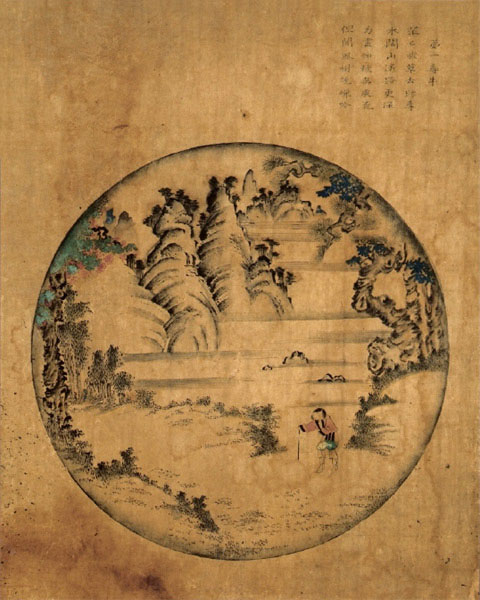
(從來不失, 何用追尋)
애초에 잃지 않았는데 어찌 찾을 필요 있겠는가.
(由背覺以成疎, 在向塵而遂失)
깨침을 등진 결과 멀어져서 세간을 향하다가 길을 잃었다.
(家山漸遠岐路俄差)
고향집에서 점차 멀어져 갈림길에서 어긋난다.
(得失熾然是非鋒起)
얻고 잃음의 불이 타오르니, 옳고 그름의 분별력도 어지럽게 일어나네.
The Search for the Bull
The bull never has been lost. What need is there to search?
Only because of separation from my true nature, I fail to find
him. In the confusion of the senses I lose even his tracks. Far
from home, I see many crossroads, but which way is the right
one I know not. Greed and fear, good and bad, entangle me.
(茫茫撥草去追尋)
아득히 펼쳐진 수풀을 헤치고 소 찾아 나서니,
수활산요로갱심(水 山遙路更深)
물은 넓고 산은 먼데 길은 더욱 깊구나.
(力盡神疲無處覓)
힘 빠지고 피로해 소 찾을 길은 없는데,
(但聞楓樹晩蟬吟)
오로지 저녁 나뭇가지 매미 울음만이 들리네.
Comment
In the pasture of this world, I endlessly push aside the tall
grasses in search of the bull. Following unnamed rivers, lost
upon the interpenetrating paths of distant mountains, My
strength failing and my vitality exhausted, I cannot find the bull.
I only hear the locusts chirring through the forest at night.
石鼓希夷
(只管區區向外尋)
오로지 급하게 밖을 향해 찾으나,
(不知脚底已泥深)
발 밑 진흙 수렁이 이미 깊은 줄도 모르네.
(幾回芳草斜陽裏)
몇 번인가, 방초 우거진 석양 속에서,
(一曲新豊空自吟)
풍년가를 부질없이 불러 봤네.
壞衲大璉
(本無 跡是誰尋)
본대 자취도 없는데 누가 찾는고,
(誤入烟蘿深處深)
우거진 등 넝쿨 깊은 곳에 잘못 들어 왔구나.
(手把鼻頭同歸客)
손으로 코 잡고 함께 돌아가는 나그네가,
(水 林下自沈吟)
물가 나무 아래서 스스로 침음한다.
2. 見跡/初調
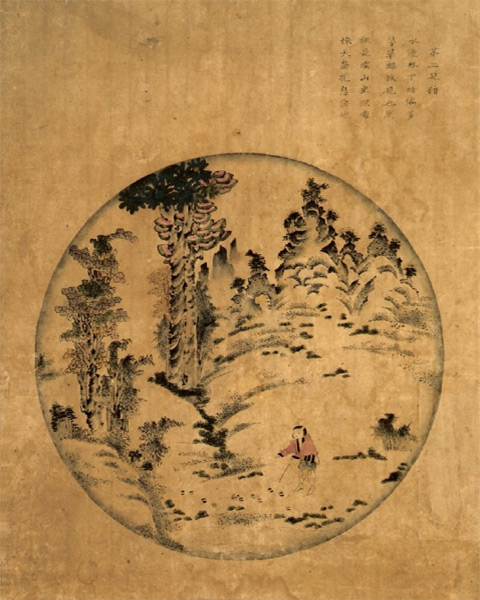
(依經解義)
경전에 의거해 뜻을 헤아리고
(閱敎知 )
가르침을 배워서 그 자취를 안다.
(明衆器爲一金)
그릇들이 다 한가지로 금임을 밝혀내고,
(體萬物爲自己)
우주만물이 곧 자기라는 사실을 체득한다.
(正邪不辨)
바름과 삿됨을 가려내지 못한다면,
(眞僞계分)
어찌 참됨과 거짓을 구분할 수 있으리오.
(未入斯門)
아직 입문하진 않았으나
(權爲見跡)
임시 방편으로 '자취를 본다'고 한다.
Discovering the Footprints
Understanding the teaching, I see the footprints of the bull.
Then I learn that, just as many utensils are made from one
metal, so too are myriad entities made of the fabric of self.
Unless I discriminate, how will I perceive the true from the
untrue? Not yet having entered the gate, nevertheless I have
discerned the path.
(水 林下跡偏多)
물가 나무 아래 발자국 어지럽게 많으니,
(芳草離披見也?)
방초를 헤치고서 그대는 보는가 못보는가?
(縱是深山更深處)
가령 깊은 산 깊은 곳에 있다 해도
(遼天鼻孔 藏他)
하늘 향한 등창코를 어찌 숨기랴!
Comment
Along the riverbank under the trees, I discover footprints!
Even under the fragrant grass I see his prints.
Deep in remote mountains they are found.
These traces no more can be hidden than one's nose, looking
heavenward.
石鼓希夷
(枯木巖前差路多)
고목나무 바위 앞에 엇갈린 길도 많다.
(草 裏 覺非?)
풀더미에 발이 걸리니 잘못인 줄 알았느냐?
(脚 若也隨他去)
발자취를 따라서 줄 곧 따라만 간다면,
(未免當頭蹉過他)
정작 마주칠 땐 그냥 지나치리라.
壞衲大璉
(見牛人少覓牛多)
소를 보는 사람은 적고 소를 찾는 이는 많다.
(山北山南見也?)
산의 북쪽과 남쪽을 보는가 마는가?
(明暗一條去來路)
밝고 어두운 한 줄기로 오가는 길,
(箇中認取別無他)
그 속에서 느껴야지 따로 있지 않다네.
3. 見牛/受制
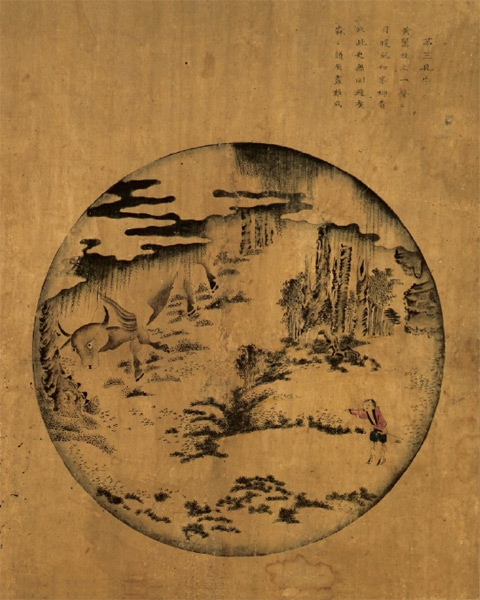
(從聲得入)
소리를 쫓아 들어가니,
(見處逢源)
보는 곳마다 근원과 마주친다.
(六根門)
여섯 기관의 문마다
(着着無差)
한치도 어긋남이 없네.
(動用中)
움직이는 작용 속에
(頭頭顯露)
낱낱이 바탕을 드러냈다.
(水中鹽味)
물 속의 소금 맛이요,
(色裏膠靑)
물감 속의 아교인데,
( 上眉毛)
눈섭을 치켜뜨고 바라봐도,
(非是他物)
별다른 물건이 아니로다.
Perceiving the Bull
When one hears the voice, one can sense its source.
As soon as the six senses merge, the gate is entered.
Wherever one enters one sees the head of the bull! This unity
is like salt in water, like color in dyestuff.
The slightest thing is not apart from self.
(黃 枝上一聲聲)
노란 꾀꼬리가 나뭇가지 위에서 지저귀고,
(日暖風和岸柳靑)
햇볕은 따사하고 바람은 서늘한데 언덕의 버들은 푸르기만 하다
(只此更無回避處)
더 이상 빠져나아 갈 곳이 다시 없나니,
(森森頭角畵難成)
위풍당당한 쇠뿔은 그리기가 어려워라.
Comment
I hear the song of the nightingale.
The sun is warm, the wind is mild, willows are green
along the shore,
Here no bull can hide!
What artist can draw that massive head, those majestic horns?
石鼓希夷
(識得形容認得聲)
소의 모습을 알아 보고 그 소리도 알아듣나니,
(戴崇從此妙丹靑)
화가 대숭이 이로부터 멋진 그 림을 그렸다네.
(徹頭徹尾渾相似)
머리 끝부터 발 끝까지 온통 비슷 하지만,
(子細看來未十成)
자세히 살펴보니 온전치는 못하구나!
壞衲大璉
(驀面相逢見而呈)
갑자기 마주치면서 얼굴을 드러내니,
(此牛非白亦非靑)
이 소가 희지도 않고 푸르지도 않구나!
(點頭自許微微笑)
스스로 머리 끄덕여 긍정하면서 빙그레 웃으니,
(一段風光畵不成)
한 줄기 풍광은 그려도 그림이 되지 않는다.
4. 得牛/廻首
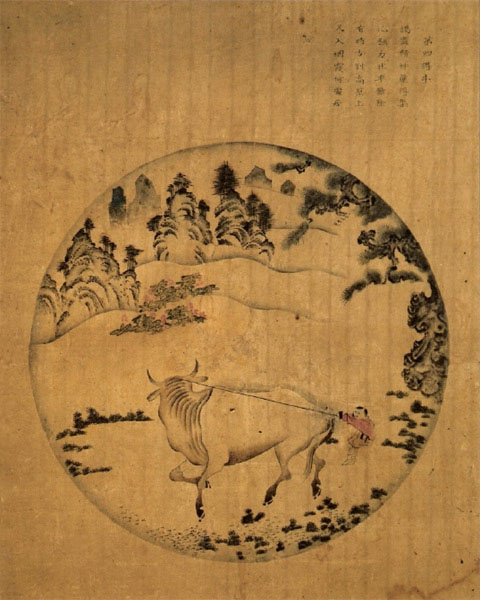
(久埋郊外)
오랫동안 야외에 숨어 있었는데,
(今日逢渠)
오늘에야 비로소 그댈 만났네.
(由境勝以難追)
뛰어난 경치 때문에 쫓아가기 어려운데,
(戀芳叢而不己)
싱그러운 수풀 속을 끊임없이 그리워 하네.
(頑心尙勇)
고집 센 마음은 여전히 날뛰니,
(野性猶存)
야성이 아직도 남아 있구나!
(欲得純和)
온순하게 하고 싶으면,
(必加鞭?)
반드시 채찍질을 가해야 한다.
Catching the Bull
He dwelt in the forest a long time, but I caught him today!
Infatuation for scenery interferes with his direction.
Longing for sweeter grass, he wanders away.
His mind still is stubborn and unbridled.
If I wish him to submit, I must raise my whip.
(竭盡精神獲得渠)
온 정신을 다하여 이 놈을 잡았으나,
(心强力壯卒難除)
힘 세고 마음 강해 다스리기 어려워라.
(有時裳到高原上)
어느 땐 고원 위에 올랐다가도,
(又入煙雲深處居)
어느 땐 구름 깊은 곳에 들어가 머무누나.
Comment
I seize him with a terrific struggle.
His great will and power are inexhaustible.
He charges to the high plateau far above the cloud-mists,
Or in an impenetrable ravine he stands.
石鼓希夷
(牢把繩頭莫放渠)
고삐를 꽉 잡고 그 놈을 놓지 말라.
(幾多毛病未曾除)
숱한 나쁜 버릇은 아직 없어지지 않았으니,
(徐徐驀鼻牽將去)
천천히 코뚜레를 꿰어 끌고 가더라도,
(且要廻頭識舊居)
또 머리를 돌려 예 있던 곳을 알고자 하네.
壞衲大璉
(芳草連天捉得渠)
방초의 하늘 닿은 데서 이 놈을 붙잡았지만
(鼻頭繩索未全除)
코 꿴 고삐가 완전히 없어지진 않았구나!
(分明照見歸家路)
고향길을 분명히 비추어 보니,
(綠水靑山暫寄居)
푸른 물 푸른 산에 잠시 머물렀을 따름이네.
5. 牧牛/馴伏
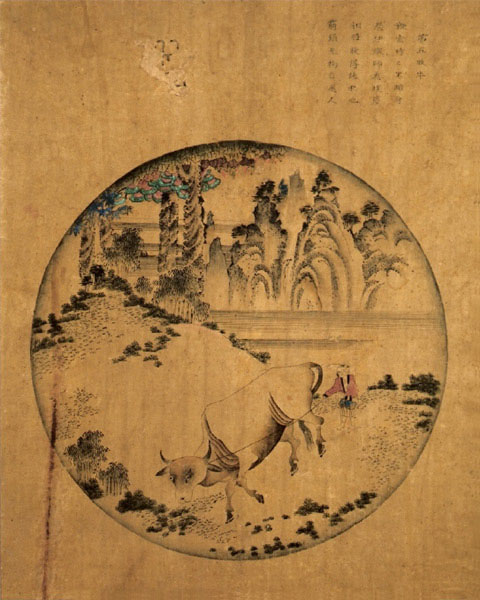
(前思裳起)
앞 생각이 조금이라도 일어나면,
(後念相隨)
뒷 생각도 뒤따르나니,
(由覺故以成眞)
깨달음을 인해 진실을 이루기도 하며,
(在迷故而爲妄)
미혹으로 인해 거짓이 되기도 한다.
(不由境有)
대상 사물 때문에 그런 것이 아니라,
(唯自心生)
오직 스스로 마음이 일어났을 뿐이요,
(鼻索牢牽)
코를 꿴 고삐를 당길 뿐이니,
(不容擬議)
사량분별은 용납치 않는다.
Taming the Bull
When one thought arises, another thought follows.
When the first thought springs from
enlightenment, all subsequent thoughts are true.
Through delusion, one makes everything untrue.
Delusion is not caused by objectivity; it is the result of
subjectivity. Hold the nose-ring
tight and do not allow even a doubt.
(鞭索時時不理身)
채찍과 고삐를 늘 몸에서 떼지 말라.
(恐伊縱步入埃塵)
두렵도다, 멋대로 걸어서 티끌 세계에 들어갈까봐.
(相將牧得純和也)
잘 길들여서 온순하게 되면,
( 鎖無拘自逐人)
고삐를 잡지 않아도 저절로 사람을 따를 것이다.
Comment
The whip and rope are necessary,
Else he might stray off down some dusty road.
Being well trained, he becomes naturally gentle.
Then, unfettered, he obeys his master.
石鼓希夷
(甘分山林寄此身)
산림이 제 분수라 여겨 즐거이 몸을 맡기고,
(有時亦蹈馬蹄塵)
어떤 때는 티끌날리는 거리로 들어간다.
(不曾犯着人苗稼)
일찍이 남의 논밭에 침범한 적은 없나니,
(來往空勞背上人)
가고 옴에 소 탄 사람은 쓸데없이 수고롭네.
壞衲大璉
(牧來純熟自通身)
완숙하게 길들여져 절로 몸에 밴다면,
(雖在塵中不染塵)
티끌 속에 있더라도 물들지 않으리라.
(弄來却得蹉 力)
타고 놀다 오히려 좌절을 겪은 덕택에,
(林下相逢笑殺人)
숲 아래서 마주치자 자지러지게 웃어대네.
6. 騎牛歸家/無碍
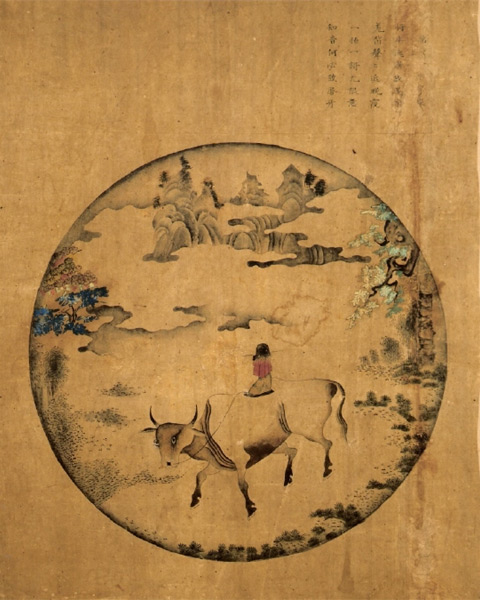
(刊戈已罷)
투쟁이 끝나서,
(得失還空)
얻음도 잃음도 모두 비었구나!
(唱椎子之村歌)
나뭇꾼의 시골노래를 흥얼거리며,
(吹兒童之野曲)
시골 아이들의 풀피리를 불어 보노라.
(身橫牛上)
태평한 모습으로 소 등에 누워,
(目視雲 )
눈은 아득한 허공을 바라본다.
(呼喚不回)
불러도 불러도 돌아보지 않고,
(撈寵不住)
끌어당겨도 더 이상 물러나지 않는다.
Riding the Bull Home
This struggle is over; gain and loss are assimilated.
I sing the song of the village woodsman, and play the tunes
of the children.
Astride the bull, I observe the clouds above.
Onward I go, no matter who may wish to call me back.
(騎牛 欲還家)
소를 타고 유유히 집으로 돌아가노라니,
( 笛聲聲送晩霞)
오랑캐 피리소리가 저녁 놀에 실려간다.
(日拍一歌無限意)
한 박자 한 곡조가 한량없는 뜻이려니,
(知音何必鼓唇牙)
곡조 아는 이라고 말할 필요가 있겠는가!
Comment
Mounting the bull, slowly I return homeward.
The voice of my flute intones through the evening.
Measuring with hand-beats the pulsating harmony,
I direct the endless rhythm.
Whoever hears this melody will join me.
石鼓希夷
(指點前坡卽是家)
앞 언덕을 가리키니 바로 집이라,
(旋吹桐角出煙霞)
이윽고 오동피리를 불며 석양 속에 나타난다.
(忽然變作還鄕曲)
홀연히 음악은 환향곡으로 바뀌나니,
(未必知音肯伯牙)
곡을 아는 자는 백아 보다 낫다 하리라.
壞衲大璉
(倒騎得得自歸家)
거꾸로 소를 타고 집에 돌아가니,
(蒻笠 衣帶晩霞)
삿갓과 도롱이도 저녁 놀에 물들었다.
(步步淸風行處穩)
걸음마다 맑은 바람에 가는 길이 편안하니,
(不將寸草掛脣牙)
빈약한 촌초로선 입을 열지 못한다네.
7. 忘牛存人/住運
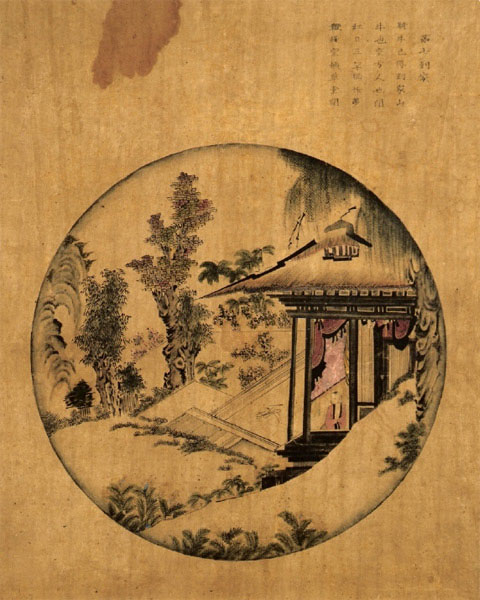
(法無二法)
법엔 두 법이 없나니,
(牛且爲宗)
임시 소에 의탁해 종으로 삼았노라.
(喩蹄兎之異名)
올가미와 토끼가 명칭이 다른 것 같고,
(顯筌魚之差別)
통발과 고기가 구별되는 것과 마찬가지일세.
(如金出鑛)
마치 금이 광석에서 나오고,
(似月離雲)
달이 구름을 벗어난 것 같으니,
(一道寒光)
한 줄기 차가운 빛은
(威音劫外)
겁 밖의 위음이로다.
The Bull Transcended
All is one law, not two.
We only make the bull a temporary subject.
It is as the relation of rabbit and trap, of fish and net.
It is as gold and dross, or the moon emerging from a cloud.
One path of clear light travels on throughout endless time.
(騎牛已得到家山)
소를 타고 이미 고향에 도착하였으니,
(牛也空兮人也閑)
소도 공하고 사람까지 한가롭네.
(紅日三竿猶作夢)
붉은 해는 높이 솟아도 여전히 꿈꾸는 것 같으니,
(鞭繩空頓草堂間)
채찍과 고삐는 띠집 사이에 부질없이 놓여 있네.
Comment
Astride the bull, I reach home.
I am serene. The bull too can rest.
The dawn has come. In blissful repose,
Within my thatched dwelling I have abandoned the whip and rope.
石鼓希夷
(欄內無牛 出山)
산에서 끌고 온 소, 집안에는 없고,
(烟 雨笠亦空閑)
삿갓과 도롱이도 쓸데 없다.
(行歌行樂無拘繫)
즐겁게 노래하며 가는 길에 전혀 걸림 없으니,
( 得一身天地間)
온 천지 사이에서 한 몸만이 자유롭네.
壞衲大璉
(歸來何處不家山)
돌아오니 어디 하나 고향 아니리,
(物我相忘鎭日閑)
대상과 나 또한 모두 잊으니 종일 한가롭네.
(須信通玄峰頂上)
현지를 통한 봉우리 정상을 반드시 믿을지니,
(箇中渾不類人間)
그 속에선 온갖 것이 인간세 아니더라.
8. 人牛俱忘 / 相忘
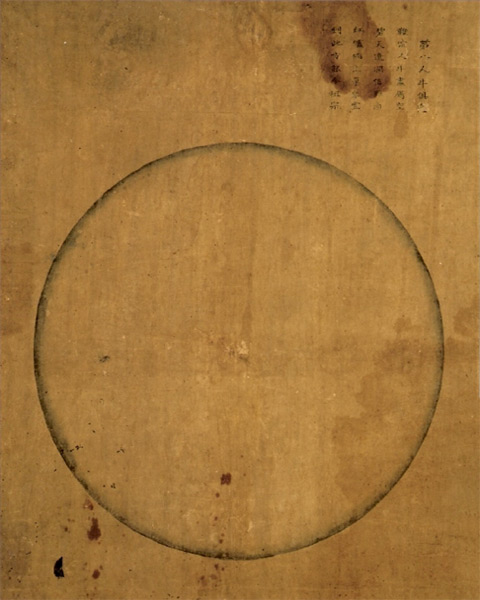
(凡情脫落)
범속한 생각을 탈락하고,
(聖意皆空)
거룩한 뜻도 다 비어 있다.
(有佛處不用 遊)
부처가 있는 세계엔 놀 필요가 없고,
(無佛處急須走過)
부처 없는 세계는 모름지기 급히 지나가야 한다.
(兩頭不着)
범속함과 거룩함 둘 다에 집착하지 않으니,
(千眼難竅)
관음보살의 천안이라도 엿보기 어려워라.
(百鳥啣華)
온갖 새들이 꽃을 물고와 공양하는 것은,
(一場 )
오히려 한바탕 부끄러운 장면일 뿐이네.
Both Bull and Self Transcended
Mediocrity is gone. Mind is clear of limitation.
I seek no state of enlightenment.
Neither do I remain where no enlightenment exists.
Since I linger in neither condition, eyes cannot see me.
If hundreds of birds strew my path with flowers,
such praise would be meaningless.
(鞭索人牛盡屬空)
채찍과 고삐, 사람과 소는 다 비어 있나니,
(壁天遼闊信難通)
푸른 허공만이 가득히 펼쳐져 소식 전하기 어렵도다.
(紅爐焰上爭容雪)
붉은 화로의 불꽃이 어찌 눈을 용납하리오
(到此方能合祖宗)
이 경지에 이르러야 조사의 마음과 합치게 되리라.
Comment
Whip, rope, person, and bull -- all merge in No-Thing.
This heaven is so vast no message can stain it.
How may a snowflake exist in a raging fire?
Here are the footprints of the patriarchs.
石鼓希夷
( 愧衆生界已空)
부끄럽구나! 중생계도 이미 비었으니,
(箇中消息若爲通)
그 가운데 소식을 어찌 통할 것인가!
(後無來者前無去)
뒤에 오는 자도 없고 앞에 가는 이도 없으니,
(未審憑誰繼此宗)
모르겠다! 누구에게 종지를 계승한다고 하는지를.
壞衲大璉
(一鎚擊碎大虛空)
한번 크게 내려 큰 허공을 부숴버리다.
(凡聖無縱路不通)
범부 성인의 자취는 없고 길도 통하지 않네.
(明月堂前風颯颯)
명월당 앞에 부는 바람은 쓸쓸한데,
(百川無水不朝宗)
세상의 모든 강들은 바다로 흘러든다.
9. 近本還源/獨照
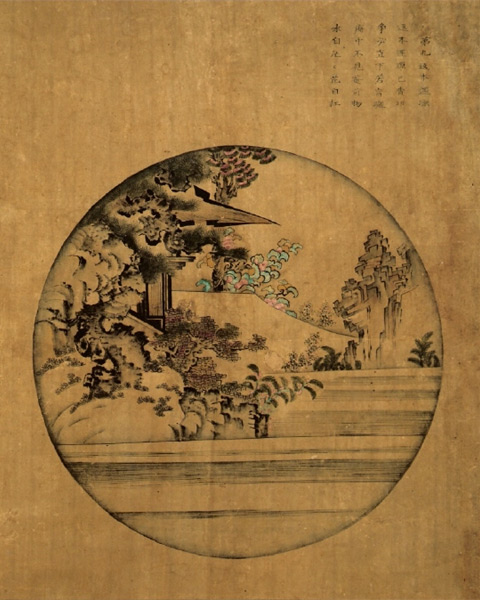
(本來淸淨不受一塵)
본래 청정해서 한 티끌에도 물들지 않으면서,
(觀有相支榮枯)
모습 있는 만유의 영고성쇠를 본다.
(處無爲之凝寂)
함이 없는 고요한 경지에 머물러,
(不同幻化)
더 이상 환상과 동일시 하지 않으니,
(豈假修治)
어찌 수행과 계율에 의지하리오!
(水綠山靑)
물은 맑게 흐르고 산은 푸르른데,
(坐觀成敗)
홀로 앉아 세상의 흥망 성쇠를 바라보노라.
Reaching the Source
From the beginning, truth is clear. Poised in silence,
I observe the forms of integration and disintegration.
One who is not attached to "form" need not be "reformed."
The water is emerald, the mountain is indigo, and I see that
which is creating and that which is destroying.
(返本還源已費功)
근원으로 돌아가 돌이켜 보니 온갖 노력을 기울였구나!
(爭如直下若盲聾)
차라리 당장에 귀머거리나 장님 같은 것을,
(庵中不見庵前物)
암자 속에 앉아 암자 밖 사물을 인지하지 않나니,
(水自茫茫花自紅)
물은 절로 아득하고 꽃은 절로 붉구나!
Comment
Too many steps have been taken returning to the root
and the source. Better to have been blind and deaf from the
beginning!
Dwelling in one's true abode, unconcerned with that without
-- The river flows tranquilly on and the flowers are red.
石鼓希夷
(靈機不墮有無功)
신령한 기틀은 유무의 공에 떨어지지 않아서,
(見色聞聲豈用聾)
빛깔도 보고 소리도 듣는데, 어찌 귀머거리이겠는가!
(昨夜金烏飛入海)
어젯밤 금가마귀가 날아서 바다로 들어가니,
(曉天依舊一輪紅)
새벽 하늘에 예와 같이 둥근 해가 떠 있도다.
壞衲大璉
(用盡機關費盡功)
기관을 다 써서 모든 노력을 했어도,
(惺惺底事不如聾)
또랑또랑한 그 일은 귀머거리만 못하네.
(草鞋根斷來時路)
짚신 끈이 다 해진 채 돌아오는 길에는,
(白鳥不啼花亂紅)
새들이 울지 않는데 꽃들만 붉게 피었어라.
10. 入廛垂手/雙泯
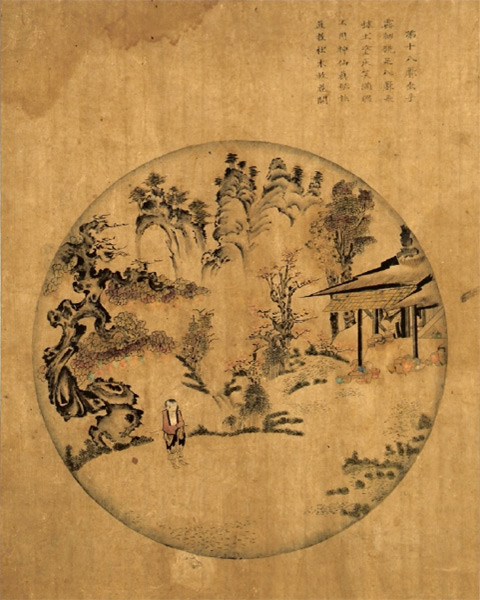
(柴門獨掩)
싸리문을 닫고 홀로 고요하니,
(千聖不知)
천명의 성인이라도 그 속을 알지 못하네.
(埋自己之風光)
자기의 풍광은 묻어 버리고,
(負前賢之途轍)
옛 성현들이 간 길들도 등져버린다.
(提瓢入市)
표주박을 들고 저자에 들어가며,
(策杖還家)
지팡이 짚고 집으로 돌아간다.
(酒肆魚行)
술집도 가고 고깃간도 들어가서,
(化令成佛)
교화를 펼쳐 부처를 이루게 한다.
In the World
Inside my gate, a thousand sages do not know me.
The beauty of my garden is invisible.
Why should one search for the footprints of the patriarchs?
I go to the market place with my wine bottle and
return home with my staff. I visit the wineshop and the market,
and everyone I look upon becomes enlightened.
(露胸跣足入廛來)
맨 가슴 맨발로 저자에 들어오니,
(抹土途灰笑滿 )
재투성이 흙투성이라도 얼굴에 가득한 함박웃음.
(不用神仙眞秘訣)
신선이 지닌 비법 따위를 쓰지 않아도,
(直敎枯木放花開)
당장에 마른 나무 위에 꽃을 피게 하누나!
Comment
Barefooted and naked of breast, I mingle with the people
of the world.
My clothes are ragged and dust-laden, and I am ever blissful.
I use no magic to extend my life;
Now, before me, the dead trees become alive.
石鼓希夷
(者漢親從異類來)
이놈은 틀림없이 이류에서 왔구나.
(分明馬面與 )
말의 얼굴과 당나귀 뺨이 너무나 분명하다.
(一揮鐵棒如風疾)
질풍처럼 몽둥이를 한번 휘둘러서,
(萬戶千門盡擊開)
이 세상의 모든 문들을 두들겨 여네.
壞衲大璉
(袖裏金木追劈面來)
소매 속의 금방망이가 정면에서 떨어지니,
(胡言漢語笑靈 )
오랑캐 말, 우리 말로도 웃음은 볼에 가득하네.
(相逢若解不相識)
서로 마주쳐도 알아보지 못함을 이해한다면,
(樓閣門庭八字開)
미륵의 누각문도 활짝 열어지리라!
The Ten Oxherding Pictures - Allegories for Our Practice
Commentary by Ji Bong
http://www.buddhism.org/board/read.cgi?board=Seon&nnew=2&y\_number=51
The ten ox-herding pictures originated in twelfth century China as an allegorical illustration of man's quest for enlightenment. Over the centuries Zen artists and teachers have produced many variations of these pictures and the accompanying commentary.
I. Looking for the ox The first picture is called "looking for the ox" and it shows a young man preparing to enter the woods to search for the ox. Our first job is to find the woods; that's where the action is. But many of us are so preoccupied with our personal problems that we don't realize that we are actually already in the middle of the woods and that it's possible to begin our search for the ox. I have a son who turned three years old recently. When he was two he wasn't talking very much, and my wife and I were concerned that he learn to speak more clearly. But he would only respond most of the time to my nine-year-old daughter, who is his hero. When she gets angry at someone she calls them a "dodo," and when she sees things that appear gross to her she calls them "ocky." Well, of course, my son had no problem acquiring these two words and everyone became a dodo … Mama was a dodo, Papa was a dodo, guests visiting our house were dodos. One night we were having dinner and he was standing in his high chair and conducting the activities of the meal. We kept saying to him, "Devin, sit down. You're going to fall and hurt yourself." But like a typical two-year-old, he didn't pay much attention. Eventually he slipped and the chair went out from under him. His chin hit the table, and he bit through his lower lip. Later he was sitting on the couch with a big swollen lip like a boxer, but he hadn't said anything since the fall. So I said to him, "Devin, are you okay now?" And he looked at me very earnestly and said, "Me dodo ocky." He was just 27 months old, and already he had attained complete self-recrimination! So our first job is just to get in touch with ourselves and realize that we're all in the woods together. I teach music at the University of Southern California. One of my favorite composers is Charles Ives, who wrote a song called "The Cage." In this song, a leopard is walking back and forth in his cage. A boy comes along and watches this leopard, and then he begins to wonder: is life anything like that, back and forth inside our own cages? In our school we teach that the four walls that lock us in our cages are wanting mind, attaching mind, checking mind, and holding mind. So we all have a self-made cage. In Zen the name for our cage is karma and it is the primary hindrance to finding a free and compassionate mind. The first ox-herding picture is teaching us that without regular practice we are largely controlled by our karma.
II. Finding the footprints In the second picture the young man realizes that he is in the woods, looks down, and actually sees the tracks of the ox. Seeing the tracks means that we can begin to believe in our direction, and we can start to formulate the questions that are at the core of meditative practice. This is called "thinking I." In Zen teaching one often hears it said that we should put down our thinking because it is an illusion and a hindrance to actual attainment. But this kind of thinking is already pretty high class. Most of us are strongly controlled by our karma, so when we begin to evaluate the direction of our life or question seriously the meaning of life, we are starting to prepare the groundwork for waking up. As Zen Master Seung Sahn says, "Don't throw out the manure of thinking, plow it under and use it to make beautiful flowers." One key to practicing effectively is that we must learn to accept and possess our conceptual "shit," whatever it is. Recognize it, accept it, breathe with it, become one with it. Therefore the first two pictures are concerned with the worlds of karma and thinking and represent in our school "opposites like this."
III. Catching a glimpse of the ox In the third picture the young man sees the tail of the ox come out from behind a tree. This means he has attained an actual taste of the essence of Zen. Probably everyone in this room has had some fleeting insight of this kind into your true nature - that is why most of us are here. It happens to some people during meditation practice, but it's more likely to occur when we are completely involved in some daily activity - playing sports, making love, doing art or music - any action in which our small I disappears for a few moments and we find ourselves just doing the activity with one hundred percent intention and clarity. Often students come to formal Zen practice to cultivate and deepen these experiences.
IV. Catching the ox In the fourth picture the young man walks into a meadow, finds the ox and ropes him around the neck. Everyone wants to capture the ox and attain kensho. But Zen Master Seung Sahn teaches that if we rope the ox too soon there is a danger that the ox might overpower us. As we do hard training our energy grows and our centers get much stronger. However, our karmic demons are also quietly growing more powerful during the process. Therefore it is important to watch our intentions and desires very carefully. But nearly all Zen students think a lot about enlightenment and have a powerful desire to capture their ox. In this fourth picture the man pulls one direction; the ox pulls another. He has some insight, but his karma and thinking mind are still present.
V. Taming the ox In the fifth picture, the man walks down the road, leading the ox behind him with a loose rein that is attached to the nostrils of the ox. Some teachers regard this as the quintessential ox-herding picture. The ox is now basically tame, but still requires diligent attention. This is like a famous anecdote about Zen Master Joju and his teacher Master Nam Cheon. One day Nam Cheon saw an apprentice monk pouring hot water into the tubs for baths and said to the monk, "Don't forget to bathe the cow." This really confused the monk: "Bathe the cow? I don't understand." So later that day when Joju returned to the temple the monk asked him, "I was pouring hot water into the tubs and Master Nam Cheon said to me, 'Don't forget to bathe the cow.' I don't understand. Has he gone crazy? What is he talking about?" Joju said, "Don't worry. I will check this out." Joju went to Nam Cheon's door. Bang, bang, bang. "Come in." Joju said, "I understand that you've been talking about bathing a cow." Nam Cheon replied, "That's right. What are you going to do about it?" Joju went over, inserted two fingers into the Master's nostrils and started leading him down the hall towards the baths. Nam Cheon cried, "Not so rough! Not so rough!" If our self-cultivation is natural and we remain awake and focused like Joju, then the ox is already following us down the path.
VI. Riding the ox home In the sixth picture the man is riding the ox back home while playing a flute. There is no longer any need to hold on to the rein. This means that the five sense organs are pure and the sixth consciousness is functioning without hindrances. We begin to perceive that our everyday experiences are, indeed, the content of an enlightened mind. However, the ox is still present. There is still some small idea of attainment present.
VII. Ox lost, man remaining In the seventh picture the man is sitting on a rock, but the ox is now gone. Perhaps the ox is off sleeping somewhere but it does not concern the man. This is quite different from the earlier pictures when he was searching for an undiscovered ox. In some versions of the pictures the man is a tiny figure in a panoramic landscape, but, however insignificant, he is still there. Once there was a great Aiki-jujitsu master who after many years gave teaching transmission to his senior student. He said, "Now you will teach and I will remain in the office, and if you need me, sometimes I will come out and help you." The students of the dojo had a big celebration that night and drank a lot of rice wine. Quite late in the evening the new head teacher led the other students back towards the dojo. They all had a little too much to drink so they weren't paying careful attention. The group walked around a corner and came up close behind a mule that was standing in the street. The mule kicked at the teacher. This new teacher did a spectacular roll, right over the rear end of the mule, and landed on his feet in a perfect fighting posture. The students all shouted, "Oh, wonderful! We never saw our old teacher do anything this incredible." They could not wait to tell the master the next morning how correct he was to give transmission to his senior student. But the next day when the master heard the story he became very angry, stripped the transmission designation from the head teacher's uniform, and said to him, "You are not ready to be a master. You must become a student once again." No one understood the master's anger. Then he said, "Come with me, I will show you the correct action in this situation with a mule!" He led the students down the street until he found the mule. As the master got about four feet from the mule's rear end he walked around him in a big circle and continued quietly down the street. Then his students understood. This is very high class teaching - be fully present and don't make anything. If one is awake, then he should never get so close to the rear end of a mule that he is able to be kicked. So making anything is a big mistake. All ideas of attainment must melt away. The ox must disappear - that is the meaning of the seventh picture.
VIII. No ox, no man The eighth picture is just an empty circle, the circle that has been the frame for the first seven pictures. Pictures three through seven are all concerned with the realm between "thinking I" and the attainment of the essence of this picture, which is sunyata or emptiness. In this picture there is no subject and no object; the man and the ox have both disappeared. But there is also no idea of negating the existence of the man or the ox. All opposites dissolve into the ground of being. In our school we call this the attainment of first enlightenment. But as long as we have any conceptualizations about what enlightenment might be like, or notions about ourselves as unusual men or women, its attainment remains a thousand miles away. This is the mind that Te Shan found when he traveled to south China to check out the Ch'an teachers. On the road he met an old woman selling rice cakes and she said to him, "I see that you are a student of the Diamond Sutra. If you can answer one question for me I'll give you free all of the rice cakes that you want, but if you cannot answer me then you are a fraud and must go away." He said to her, "I am the master of the Diamond Sutra. Ask me anything that you like." She asked him, "The Diamond Sutra says that past mind is not attainable, future mind is not attainable, and present mind is not attainable. If this is true then what kind of mind will you use to eat your rice cakes?" He was stuck and had no idea how to reply. Te Shan was a great scholar and thought that he was going to come south and expose the Ch'an masters as fakers. But instead some old woman had "hit" him. And he had no idea how to answer or what to do. We are told that he wandered aimlessly until he found the residence of Ch'an Master Lung Tan. They talked long into the night and we might imagine how Te Shan was trying to justify himself to the Master who listened patiently. Finally when Te Shan's mind was completely stuck and he was totally frustrated, Lung Tan said to him, "Why don't you take the hut at the end of the path and get some rest." Te Shan went out into the night and discovered that it was pitch black. He went back into the Master's hut and said, "I can't see anything outside." The Master said, "No problem. Wait here." Lung Tan lit a candle and handed it to Te Shan. Just as Te Shan was about to take his first step into the darkness, Lung Tan blew out the candle. PA! Everything became completely open and Te Shan attained this mind without subject, without object, not empty, not full - an experience of unbounded openness. In our school we call this "without like this." Please note that pictures three through eight all are illustrative of the attainment of this first enlightenment experience, which the Heart Sutra calls nirvana. For most of us, connecting in this way with the ground of our being requires a long seasoning process involving years of diligent practice. But this is still only the eighth picture.
IX. Returning to the source In the ninth picture there is no man, but a beautiful landscape returns. White clouds pass in front of blue mountains; spring comes and the grass grows by itself; trees grow up and water flows down. This picture means that everything in this universe is already completely expressing its inherent Buddha nature. And our sense organs are capable of revealing this truth to us moment by moment. What we see, smell, hear, taste, and touch is the complete truth. The Heart Sutra names this state anuttara samyak sambodhi, perfect unexcelled truth. In our school we call this condition "only like this." Buddha sat under the tree in a samadhi of unbounded openness, perceived the particularity of the morning star and attained this mind, which we call original enlightenment. That is the essence of the ninth picture.
X. In town with helping hands But one last step remains. Our school especially emphasizes the tenth picture throughout our entire training. In the last picture the man appears again, but now he is older, bald and a little heavy. He is usually shown in the middle of the city with children all around, and he is like Hotei, passing out dharma presents to these baby bodhisattvas. This is final enlightenment and it is not special in the way that most of us conceive when we begin our Zen journey. This picture teaches us that we are to return to the existential world. But we return with a simple, clear and unattached mind that focuses on perceiving our correct relationship and correct situation in each moment. If we practice unceasingly with that intention then our actions will become generous, spontaneous, creative, effortless, and compassionate. This is the true meaning of Zen and it is the same as Nam Cheon's everyday mind or Taoism's wu wei (not doing). Our school calls this condition "just like this." I'll conclude as I began, with another story about my son. Last year at Easter was the first time that he understood what a holiday was, and he had a grand old time. My wife is really into holiday celebrations, so she had presents for the kids and she hid eggs all around the yard and in the house. It was the first time that he had experienced anything like this, so his eyes were as big as saucers all morning. In the afternoon I noticed him in his room, playing with his new toys and singing to himself. As I listened closely I heard that he was singing to himself over and over, "Thank you, rabbit. Thank you, rabbit." He had this completely open, generous kind of mind. And that is the meaning of the tenth picture and the essential meaning of Zen - "just like this" moment by moment for ten thousand years we must try, try, try to keep this clear, generous, and open bodhisattva spirit.